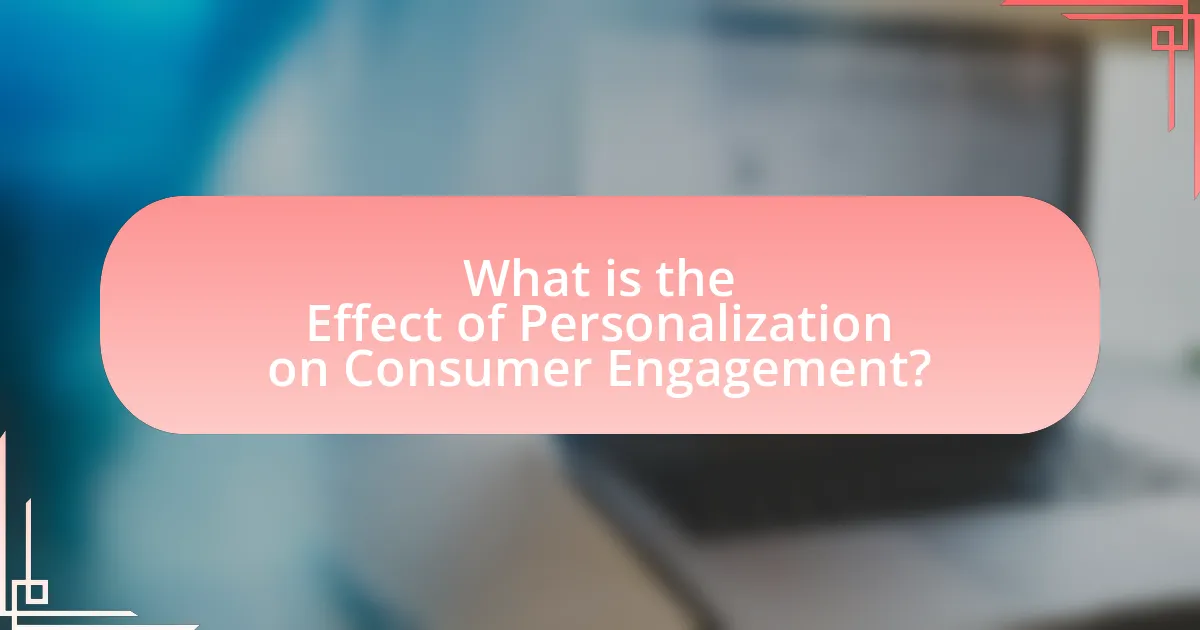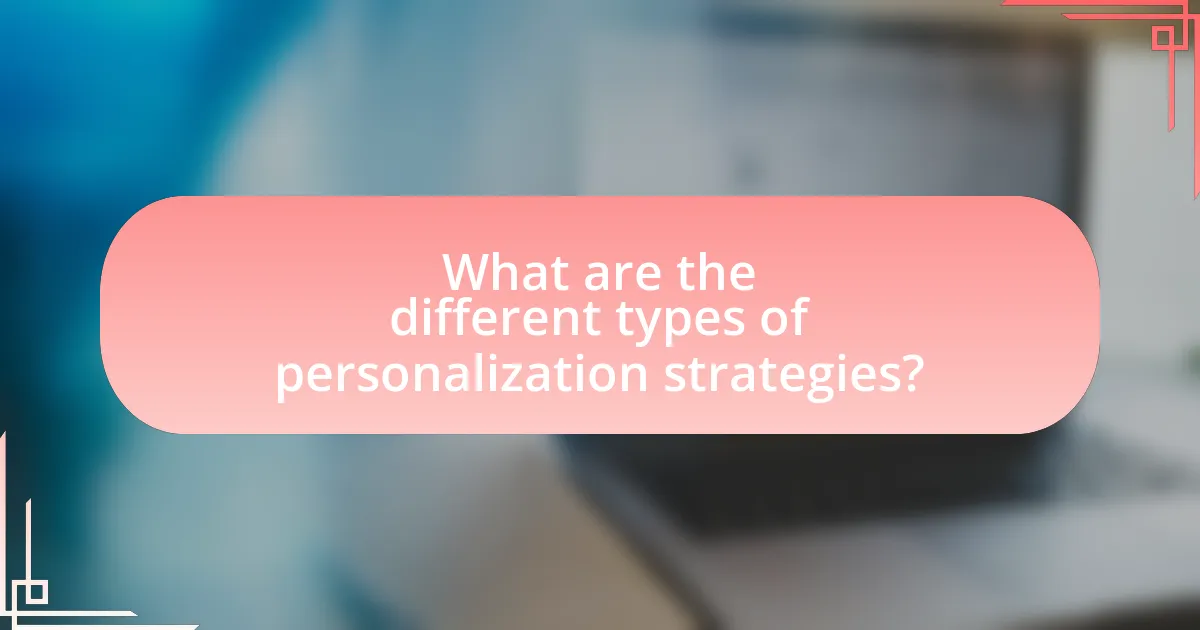Personalization is a crucial factor in enhancing consumer engagement, significantly influencing purchasing behavior and brand loyalty. Research indicates that personalized marketing can lead to substantial increases in sales and engagement metrics, with tailored experiences resonating more effectively with consumers. The article explores the psychological factors affected by personalization, the impact on decision-making processes, and the importance of consumer engagement for businesses. It also discusses various personalization strategies, the role of data, challenges faced by businesses, and best practices for implementation, while highlighting future trends in personalization driven by advancements in technology.

What is the Effect of Personalization on Consumer Engagement?
Personalization significantly enhances consumer engagement by tailoring experiences to individual preferences and behaviors. Research indicates that personalized marketing can lead to a 20% increase in sales and a 10% increase in customer engagement metrics, as consumers are more likely to interact with content that resonates with their specific interests. For instance, a study by McKinsey & Company found that personalized recommendations can drive a 10-30% increase in conversion rates, demonstrating the effectiveness of personalization in capturing consumer attention and fostering loyalty.
How does personalization influence consumer behavior?
Personalization significantly influences consumer behavior by enhancing the relevance of marketing messages and product offerings to individual preferences. When consumers receive tailored recommendations or communications, they are more likely to engage with the brand, leading to increased purchase intent and loyalty. Research indicates that 80% of consumers are more likely to make a purchase when brands offer personalized experiences, as highlighted in a study by Epsilon, which emphasizes the importance of personalization in driving consumer decisions.
What psychological factors are affected by personalization?
Personalization affects several psychological factors, including motivation, emotional connection, and perceived relevance. Motivation is influenced as personalized experiences can enhance a consumer’s desire to engage with a product or service, leading to increased purchasing behavior. Emotional connection is strengthened through tailored content that resonates with individual preferences, fostering brand loyalty. Perceived relevance increases when consumers feel that the offerings are specifically designed for them, which can enhance satisfaction and reduce decision fatigue. Research indicates that personalized marketing can lead to a 20% increase in sales, demonstrating the significant impact of these psychological factors on consumer engagement.
How does personalization impact decision-making processes?
Personalization significantly enhances decision-making processes by tailoring information and options to individual preferences and behaviors. This targeted approach increases relevance, leading to quicker and more confident choices. Research indicates that personalized experiences can improve user engagement by up to 80%, as consumers are more likely to respond positively to content that resonates with their specific interests and needs. For instance, a study by McKinsey & Company found that personalization can lead to a 10-30% increase in sales, demonstrating that when consumers feel understood, they are more inclined to make purchasing decisions.
Why is consumer engagement important for businesses?
Consumer engagement is crucial for businesses because it directly influences customer loyalty and revenue growth. Engaged consumers are more likely to make repeat purchases, advocate for the brand, and provide valuable feedback. According to a study by Gallup, companies with high levels of customer engagement achieve 23% higher profitability compared to their competitors. This correlation highlights that fostering strong consumer relationships through personalized experiences can significantly enhance business performance.
What metrics are used to measure consumer engagement?
Metrics used to measure consumer engagement include customer retention rate, net promoter score (NPS), customer lifetime value (CLV), and social media engagement metrics such as likes, shares, and comments. Customer retention rate quantifies the percentage of customers who continue to engage with a brand over a specific period, indicating loyalty and satisfaction. Net promoter score assesses customer willingness to recommend a brand, reflecting overall sentiment and engagement. Customer lifetime value estimates the total revenue a business can expect from a single customer account, highlighting the long-term value of engagement. Social media engagement metrics provide insights into how consumers interact with content, showcasing the effectiveness of marketing strategies. These metrics collectively offer a comprehensive view of consumer engagement levels.
How does consumer engagement affect brand loyalty?
Consumer engagement significantly enhances brand loyalty by fostering emotional connections and trust between consumers and brands. Engaged consumers are more likely to develop a sense of belonging and attachment to a brand, which leads to repeat purchases and advocacy. Research indicates that brands with high consumer engagement levels can achieve loyalty rates up to 60% higher than those with lower engagement, as seen in a study by Gallup, which found that emotionally engaged customers are more likely to recommend a brand and remain loyal over time. This correlation underscores the importance of effective engagement strategies in cultivating long-term brand loyalty.

What are the different types of personalization strategies?
The different types of personalization strategies include demographic personalization, behavioral personalization, contextual personalization, and predictive personalization. Demographic personalization targets users based on characteristics such as age, gender, and location, allowing businesses to tailor content to specific audience segments. Behavioral personalization utilizes data on user interactions, such as browsing history and purchase behavior, to create customized experiences that resonate with individual preferences. Contextual personalization adapts content based on the user’s current situation, such as time of day or device used, enhancing relevance and engagement. Predictive personalization employs algorithms to anticipate user needs and preferences, often resulting in proactive recommendations that improve user satisfaction. These strategies are supported by research indicating that personalized experiences can significantly increase consumer engagement and conversion rates.
How do personalized recommendations work?
Personalized recommendations work by analyzing user data to predict preferences and suggest relevant products or content. This process typically involves algorithms that utilize historical behavior, such as past purchases, browsing history, and demographic information, to create a user profile. For instance, collaborative filtering compares a user’s behavior with that of similar users to identify items they may like, while content-based filtering recommends items similar to those the user has previously engaged with. Research shows that personalized recommendations can increase engagement by up to 30%, as they cater to individual tastes and enhance the user experience.
What algorithms are commonly used for personalized recommendations?
Common algorithms used for personalized recommendations include collaborative filtering, content-based filtering, and hybrid methods. Collaborative filtering analyzes user behavior and preferences to suggest items based on similar users’ choices, while content-based filtering recommends items similar to those a user has liked in the past. Hybrid methods combine both approaches to enhance recommendation accuracy. Research indicates that collaborative filtering can improve user engagement by up to 30%, demonstrating its effectiveness in personalization strategies.
How effective are personalized recommendations in driving sales?
Personalized recommendations are highly effective in driving sales, with studies indicating that they can increase conversion rates by up to 10 times. This effectiveness stems from the ability of personalized recommendations to cater to individual consumer preferences, leading to a more relevant shopping experience. For instance, a study by McKinsey & Company found that 35% of what consumers purchase on Amazon comes from product recommendations, highlighting the significant impact of tailored suggestions on sales. Additionally, research published in the Journal of Marketing Research shows that personalized marketing can lead to a 20% increase in sales, demonstrating the strong correlation between personalization and consumer purchasing behavior.
What role does data play in personalization?
Data is essential for personalization as it enables businesses to tailor experiences and offerings to individual preferences and behaviors. By analyzing consumer data, such as purchase history, browsing patterns, and demographic information, companies can create targeted marketing strategies that resonate with specific audiences. For instance, a study by McKinsey & Company found that personalized recommendations can lead to a 10-30% increase in sales, demonstrating the direct impact of data-driven personalization on consumer engagement.
What types of data are essential for effective personalization?
Effective personalization relies on several essential types of data, including demographic data, behavioral data, transactional data, and psychographic data. Demographic data, such as age, gender, and location, helps businesses understand their audience segments. Behavioral data, which tracks user interactions and engagement patterns, provides insights into preferences and habits. Transactional data, including purchase history and frequency, informs businesses about customer loyalty and spending behavior. Psychographic data, encompassing interests, values, and lifestyle choices, allows for deeper emotional connections with consumers. Collectively, these data types enable tailored experiences that enhance consumer engagement and satisfaction.
How can businesses ensure data privacy while personalizing experiences?
Businesses can ensure data privacy while personalizing experiences by implementing robust data protection measures and transparent data usage policies. These measures include utilizing encryption to safeguard personal information, anonymizing data to prevent identification of individuals, and obtaining explicit consent from users before collecting or processing their data. According to a 2021 survey by the International Association of Privacy Professionals, 79% of consumers express concern about how their data is used, highlighting the importance of transparency and trust in data practices. By prioritizing these strategies, businesses can effectively balance personalization with the need for data privacy, fostering consumer trust and engagement.

What challenges do businesses face with personalization?
Businesses face several challenges with personalization, primarily related to data privacy, integration of technology, and maintaining relevance. Data privacy concerns arise as consumers become increasingly aware of how their information is used, leading to stricter regulations like GDPR that businesses must navigate. Integration of technology is another challenge, as companies often struggle to unify data from various sources to create a cohesive personalized experience. Additionally, maintaining relevance is crucial; businesses must continuously analyze consumer behavior to ensure that personalized content resonates, which can be resource-intensive. These challenges highlight the complexity of effectively implementing personalization strategies in a competitive market.
How can businesses overcome personalization fatigue among consumers?
Businesses can overcome personalization fatigue among consumers by implementing a balanced approach that prioritizes relevance and value over excessive targeting. This involves utilizing data analytics to understand consumer preferences and behaviors, allowing businesses to tailor experiences without overwhelming users with constant personalization. Research indicates that 71% of consumers feel frustrated when their shopping experience is too personalized, highlighting the need for moderation. By focusing on delivering meaningful content and respecting consumer privacy, businesses can enhance engagement while reducing the risk of fatigue.
What strategies can mitigate the risks of over-personalization?
To mitigate the risks of over-personalization, companies can implement strategies such as maintaining a balance between personalization and privacy, utilizing diverse data sources, and allowing user control over personalization settings. Balancing personalization with privacy ensures that consumers feel secure and not overly targeted, which can enhance trust. Utilizing diverse data sources, rather than relying solely on past behavior, helps create a more holistic view of consumer preferences, reducing the risk of assumptions that may not hold true. Allowing users to control their personalization settings empowers them to adjust their experience, which can lead to greater satisfaction and engagement. These strategies are supported by research indicating that consumers prefer brands that respect their privacy while still providing relevant content.
How can businesses balance personalization with user privacy concerns?
Businesses can balance personalization with user privacy concerns by implementing transparent data practices and obtaining explicit consent from users. Transparency involves clearly communicating how user data will be collected, used, and shared, which builds trust and allows consumers to make informed decisions. For instance, a study by the Pew Research Center found that 79% of Americans are concerned about how their data is being used by companies, highlighting the importance of addressing privacy concerns. Additionally, businesses can utilize privacy-preserving technologies, such as differential privacy, which allows for data analysis without compromising individual user identities. By prioritizing user consent and employing privacy-centric strategies, businesses can enhance personalization while respecting user privacy.
What are the best practices for implementing personalization?
The best practices for implementing personalization include collecting and analyzing customer data, segmenting audiences, and delivering tailored content. Collecting data through various channels, such as website interactions and purchase history, allows businesses to understand customer preferences. Segmenting audiences based on demographics, behavior, and interests enables targeted messaging, which has been shown to increase engagement rates by up to 50%. Delivering tailored content, such as personalized recommendations or targeted emails, enhances the customer experience and fosters loyalty, as evidenced by a study from McKinsey, which found that personalized experiences can lead to a 10-15% increase in sales.
How can businesses effectively segment their audience for personalization?
Businesses can effectively segment their audience for personalization by utilizing data analytics to identify distinct customer groups based on demographics, behaviors, and preferences. By analyzing customer data, such as purchase history and online interactions, businesses can create targeted marketing strategies that resonate with specific segments. For instance, a study by McKinsey & Company found that personalized marketing can lead to a 10-30% increase in revenue, demonstrating the effectiveness of tailored approaches. Additionally, employing tools like customer relationship management (CRM) systems allows businesses to track and analyze customer interactions, further refining their segmentation efforts.
What tools and technologies are recommended for personalization efforts?
Recommended tools and technologies for personalization efforts include customer relationship management (CRM) systems, data analytics platforms, and machine learning algorithms. CRM systems like Salesforce enable businesses to manage customer interactions and tailor experiences based on individual preferences. Data analytics platforms such as Google Analytics provide insights into user behavior, allowing for targeted marketing strategies. Machine learning algorithms, utilized in tools like Adobe Experience Cloud, analyze vast amounts of data to predict customer needs and personalize content effectively. These technologies collectively enhance consumer engagement by delivering relevant experiences based on data-driven insights.
What future trends can we expect in personalization and consumer engagement?
Future trends in personalization and consumer engagement will increasingly focus on artificial intelligence and machine learning to deliver hyper-personalized experiences. These technologies enable brands to analyze vast amounts of consumer data in real-time, allowing for tailored recommendations and targeted marketing strategies. According to a report by McKinsey, companies that excel in personalization can achieve a 10-15% increase in revenue, highlighting the financial benefits of adopting advanced personalization techniques. Additionally, the rise of omnichannel strategies will ensure that consumers receive consistent and personalized interactions across various platforms, enhancing overall engagement.
How will advancements in AI and machine learning shape personalization?
Advancements in AI and machine learning will significantly enhance personalization by enabling more accurate data analysis and predictive modeling. These technologies allow businesses to analyze vast amounts of consumer data in real-time, identifying patterns and preferences that inform tailored marketing strategies. For instance, machine learning algorithms can process user behavior data to predict future actions, leading to personalized recommendations that increase engagement. Research from McKinsey indicates that companies utilizing AI for personalization can achieve a 10-30% increase in revenue, demonstrating the effectiveness of these advancements in driving consumer engagement.
What emerging technologies could enhance consumer engagement through personalization?
Emerging technologies that could enhance consumer engagement through personalization include artificial intelligence (AI), machine learning, augmented reality (AR), and blockchain. AI and machine learning enable businesses to analyze consumer data and predict preferences, allowing for tailored recommendations and experiences. For instance, a study by McKinsey & Company found that companies using AI for personalization can increase their revenue by 10-30%. Augmented reality enhances consumer interaction by providing immersive experiences, such as virtual try-ons, which can lead to higher engagement rates. Additionally, blockchain technology can improve data security and transparency, fostering trust in personalized services. These technologies collectively create a more engaging and customized consumer experience.


